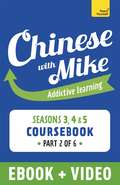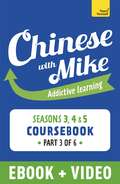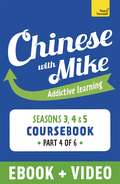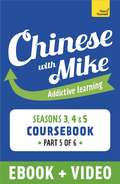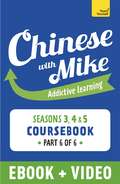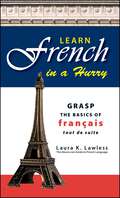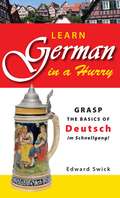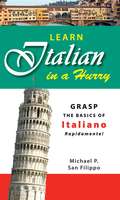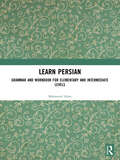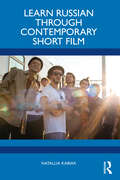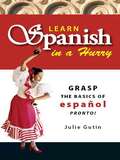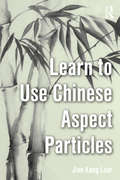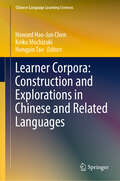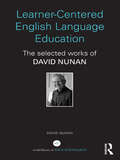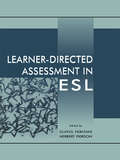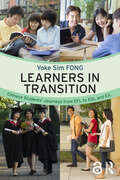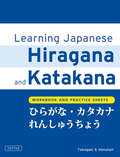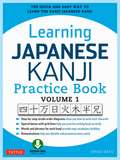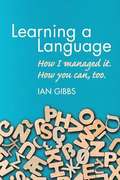- Table View
- List View
Learn Chinese with Mike Advanced Beginner to Intermediate Coursebook Seasons 3, 4 & 5: Enhanced Edition Part 2
by Mike Hainzinger"It is definitely new, and it definitely works." -Dr. Licheng Gu, Program Director, African & Asian Languages, Northwestern University What do I get when I learn Chinese with Mike? This ebook contains 10 video-based lessons and is part four of a series of six. It features audio and visual learning material and works best on tablets and smartphones. Addictive learning Mike Laoshi (Teacher Mike) will astound you with his unparalleled ability to make learning Mandarin Chinese fun and easy. Be warned, his teaching style is highly addictive, so if you have a family, career or social life, you may want to put those on hold for a little while. Why Chinese with Mike? Chinese with Mike is 100% new and breaks with traditional Chinese curricula. Mike's humour, mixed with his logical, step-by-step approach shields learners from the unnecessary complexities of Mandarin Chinese. Through a blend of short and highly addictive video lessons, you'll acquire essential Chinese with confidence. More importantly, you get a little one-on-one time with Mike, as he makes learning Chinese ridiculously easy-and fun! What will I learn? Season 3 Learn to tell people the milk is in the refrigerator and your dirty clothes are under the bed. You'll also learn about jobs, dreams and measure words. Season 4 You'll learn some new adjectives, adverbs, prepositions and conjunctions and best of all, you'll get to watch Mike Laoshi's ballet lesson and retirement press conference. Season 5 This was never meant to be, but Mike Laoshi was lured out of retirement. You'll learn how to make comparisons (I am smarter than you) and use superlatives (This is the best Chinese book ever!). Also talk about the past and the future and use transitions to put events in sequence. Why will learning Chinese be a breeze? · Mike builds confidence through his logical step-by-step design of the course · Mike explains pronunciation with clear, familiar examples · Mike adds interesting facts about the intricacies of language · Mike includes lots of cultural tidbits · Mike recognizes and explains thoroughly troublesome areas · Mike uses native speakers to help you with listening and speaking Chinese with Mike is suitable for classroom, self-study or home schooling. Praise for Mike The coolest Chinese teacher out there. Totally rad!! confusedlaowai.com Like a rock star teacher. Excellent for beginners. Entertaining too! socialmandarin.com As an instructor, I have found Prof. Hainzinger's teaching material was very practical; it was very easy to be inserted into our classroom activities because of its fragmented structural style, and its companying video files. In addition, the students really appreciated the lively style of the text, as well the vivid video contributions. Yuxiang Liu Lecturer in Chinese, EALC The University of Chicago
Learn Chinese with Mike Advanced Beginner to Intermediate Coursebook Seasons 3, 4 & 5: Enhanced Edition Part 3
by Mike Hainzinger"It is definitely new, and it definitely works." -Dr. Licheng Gu, Program Director, African & Asian Languages, Northwestern University What do I get when I learn Chinese with Mike? This ebook contains 10 video-based lessons and is part four of a series of six. It features audio and visual learning material and works best on tablets and smartphones. Addictive learning Mike Laoshi (Teacher Mike) will astound you with his unparalleled ability to make learning Mandarin Chinese fun and easy. Be warned, his teaching style is highly addictive, so if you have a family, career or social life, you may want to put those on hold for a little while. Why Chinese with Mike? Chinese with Mike is 100% new and breaks with traditional Chinese curricula. Mike's humour, mixed with his logical, step-by-step approach shields learners from the unnecessary complexities of Mandarin Chinese. Through a blend of short and highly addictive video lessons, you'll acquire essential Chinese with confidence. More importantly, you get a little one-on-one time with Mike, as he makes learning Chinese ridiculously easy-and fun! What will I learn? Season 3 Learn to tell people the milk is in the refrigerator and your dirty clothes are under the bed. You'll also learn about jobs, dreams and measure words. Season 4 You'll learn some new adjectives, adverbs, prepositions and conjunctions and best of all, you'll get to watch Mike Laoshi's ballet lesson and retirement press conference. Season 5 This was never meant to be, but Mike Laoshi was lured out of retirement. You'll learn how to make comparisons (I am smarter than you) and use superlatives (This is the best Chinese book ever!). Also talk about the past and the future and use transitions to put events in sequence. Why will learning Chinese be a breeze? · Mike builds confidence through his logical step-by-step design of the course · Mike explains pronunciation with clear, familiar examples · Mike adds interesting facts about the intricacies of language · Mike includes lots of cultural tidbits · Mike recognizes and explains thoroughly troublesome areas · Mike uses native speakers to help you with listening and speaking Chinese with Mike is suitable for classroom, self-study or home schooling. Praise for Mike The coolest Chinese teacher out there. Totally rad!! confusedlaowai.com Like a rock star teacher. Excellent for beginners. Entertaining too! socialmandarin.com As an instructor, I have found Prof. Hainzinger's teaching material was very practical; it was very easy to be inserted into our classroom activities because of its fragmented structural style, and its companying video files. In addition, the students really appreciated the lively style of the text, as well the vivid video contributions. Yuxiang Liu Lecturer in Chinese, EALC The University of Chicago
Learn Chinese with Mike Advanced Beginner to Intermediate Coursebook Seasons 3, 4 & 5: Enhanced Edition Part 4
by Mike Hainzinger"It is definitely new, and it definitely works." -Dr. Licheng Gu, Program Director, African & Asian Languages, Northwestern University What do I get when I learn Chinese with Mike? This ebook contains 10 video-based lessons and is part four of a series of six. It features audio and visual learning material and works best on tablets and smartphones. Addictive learning Mike Laoshi (Teacher Mike) will astound you with his unparalleled ability to make learning Mandarin Chinese fun and easy. Be warned, his teaching style is highly addictive, so if you have a family, career or social life, you may want to put those on hold for a little while. Why Chinese with Mike? Chinese with Mike is 100% new and breaks with traditional Chinese curricula. Mike's humour, mixed with his logical, step-by-step approach shields learners from the unnecessary complexities of Mandarin Chinese. Through a blend of short and highly addictive video lessons, you'll acquire essential Chinese with confidence. More importantly, you get a little one-on-one time with Mike, as he makes learning Chinese ridiculously easy-and fun! What will I learn? Season 3 Learn to tell people the milk is in the refrigerator and your dirty clothes are under the bed. You'll also learn about jobs, dreams and measure words. Season 4 You'll learn some new adjectives, adverbs, prepositions and conjunctions and best of all, you'll get to watch Mike Laoshi's ballet lesson and retirement press conference. Season 5 This was never meant to be, but Mike Laoshi was lured out of retirement. You'll learn how to make comparisons (I am smarter than you) and use superlatives (This is the best Chinese book ever!). Also talk about the past and the future and use transitions to put events in sequence. Why will learning Chinese be a breeze? · Mike builds confidence through his logical step-by-step design of the course · Mike explains pronunciation with clear, familiar examples · Mike adds interesting facts about the intricacies of language · Mike includes lots of cultural tidbits · Mike recognizes and explains thoroughly troublesome areas · Mike uses native speakers to help you with listening and speaking Chinese with Mike is suitable for classroom, self-study or home schooling. Praise for Mike The coolest Chinese teacher out there. Totally rad!! confusedlaowai.com Like a rock star teacher. Excellent for beginners. Entertaining too! socialmandarin.com As an instructor, I have found Prof. Hainzinger's teaching material was very practical; it was very easy to be inserted into our classroom activities because of its fragmented structural style, and its companying video files. In addition, the students really appreciated the lively style of the text, as well the vivid video contributions. Yuxiang Liu Lecturer in Chinese, EALC The University of Chicago
Learn Chinese with Mike Advanced Beginner to Intermediate Coursebook Seasons 3, 4 & 5: Enhanced Edition Part 5
by Mike Hainzinger"It is definitely new, and it definitely works." -Dr. Licheng Gu, Program Director, African & Asian Languages, Northwestern University What do I get when I learn Chinese with Mike? This ebook contains 10 video-based lessons and is part five of a series of six. It features audio and visual learning material and works best on tablets and smartphones. Addictive learning Mike Laoshi (Teacher Mike) will astound you with his unparalleled ability to make learning Mandarin Chinese fun and easy. Be warned, his teaching style is highly addictive, so if you have a family, career or social life, you may want to put those on hold for a little while. Why Chinese with Mike? Chinese with Mike is 100% new and breaks with traditional Chinese curricula. Mike's humour, mixed with his logical, step-by-step approach shields learners from the unnecessary complexities of Mandarin Chinese. Through a blend of short and highly addictive video lessons, you'll acquire essential Chinese with confidence. More importantly, you get a little one-on-one time with Mike, as he makes learning Chinese ridiculously easy-and fun! What will I learn? Season 3 Learn to tell people the milk is in the refrigerator and your dirty clothes are under the bed. You'll also learn about jobs, dreams and measure words. Season 4 You'll learn some new adjectives, adverbs, prepositions and conjunctions and best of all, you'll get to watch Mike Laoshi's ballet lesson and retirement press conference. Season 5 This was never meant to be, but Mike Laoshi was lured out of retirement. You'll learn how to make comparisons (I am smarter than you) and use superlatives (This is the best Chinese book ever!). Also talk about the past and the future and use transitions to put events in sequence. Why will learning Chinese be a breeze? · Mike builds confidence through his logical step-by-step design of the course · Mike explains pronunciation with clear, familiar examples · Mike adds interesting facts about the intricacies of language · Mike includes lots of cultural tidbits · Mike recognizes and explains thoroughly troublesome areas · Mike uses native speakers to help you with listening and speaking Chinese with Mike is suitable for classroom, self-study or home schooling. Praise for Mike The coolest Chinese teacher out there. Totally rad!! confusedlaowai.com Like a rock star teacher. Excellent for beginners. Entertaining too! socialmandarin.com As an instructor, I have found Prof. Hainzinger's teaching material was very practical; it was very easy to be inserted into our classroom activities because of its fragmented structural style, and its companying video files. In addition, the students really appreciated the lively style of the text, as well the vivid video contributions. Yuxiang Liu Lecturer in Chinese, EALC The University of Chicago
Learn Chinese with Mike Advanced Beginner to Intermediate Coursebook Seasons 3, 4 & 5: Enhanced Edition Part 6
by Mike Hainzinger"It is definitely new, and it definitely works." -Dr. Licheng Gu, Program Director, African & Asian Languages, Northwestern University What do I get when I learn Chinese with Mike? This ebook contains 10 video-based lessons and is part four of a series of six. It features audio and visual learning material and works best on tablets and smartphones. Addictive learning Mike Laoshi (Teacher Mike) will astound you with his unparalleled ability to make learning Mandarin Chinese fun and easy. Be warned, his teaching style is highly addictive, so if you have a family, career or social life, you may want to put those on hold for a little while. Why Chinese with Mike? Chinese with Mike is 100% new and breaks with traditional Chinese curricula. Mike's humour, mixed with his logical, step-by-step approach shields learners from the unnecessary complexities of Mandarin Chinese. Through a blend of short and highly addictive video lessons, you'll acquire essential Chinese with confidence. More importantly, you get a little one-on-one time with Mike, as he makes learning Chinese ridiculously easy-and fun! What will I learn? Season 3 Learn to tell people the milk is in the refrigerator and your dirty clothes are under the bed. You'll also learn about jobs, dreams and measure words. Season 4 You'll learn some new adjectives, adverbs, prepositions and conjunctions and best of all, you'll get to watch Mike Laoshi's ballet lesson and retirement press conference. Season 5 This was never meant to be, but Mike Laoshi was lured out of retirement. You'll learn how to make comparisons (I am smarter than you) and use superlatives (This is the best Chinese book ever!). Also talk about the past and the future and use transitions to put events in sequence. Why will learning Chinese be a breeze? · Mike builds confidence through his logical step-by-step design of the course · Mike explains pronunciation with clear, familiar examples · Mike adds interesting facts about the intricacies of language · Mike includes lots of cultural tidbits · Mike recognizes and explains thoroughly troublesome areas · Mike uses native speakers to help you with listening and speaking Chinese with Mike is suitable for classroom, self-study or home schooling. Praise for Mike The coolest Chinese teacher out there. Totally rad!! confusedlaowai.com Like a rock star teacher. Excellent for beginners. Entertaining too! socialmandarin.com As an instructor, I have found Prof. Hainzinger's teaching material was very practical; it was very easy to be inserted into our classroom activities because of its fragmented structural style, and its companying video files. In addition, the students really appreciated the lively style of the text, as well the vivid video contributions. Yuxiang Liu Lecturer in Chinese, EALC The University of Chicago
Learn French In A Hurry: Grasp the Basics of Francais Tout De Suite
by Laura LawlessSure, you can blurt out Merci! and Oui! Oui! and Garcon! as well as the next tourist, but in truth your French lacks a certain je ne sais quoi. That just won't do if you're touring the City of Light or sunning in Tahiti or ordering a la carte in a Montreal cafe. Whether you're traveling to a French-speaking country or learning French for business, this pocket-sized primer is your passeport to one of the world's most beautiful - and useful - languages.Learn French in a Hurry features:Common French phrases (days of the week, numbers, letters)Pronunciation and conjugation tips and tricksGrammar made easyUseful words and termsHelpful French-English and English-French dictionariesWith Learn French in a Hurry, you'll master le francais right away!
Learn German in a Hurry
by Edward SwickYou may recognize the distinct sound of the German language when you hear it-but that's not enough if you're planning a trip to a German-speaking country, is it? What if you want to get a head start for your first language class? Wouldn't it be nice to be able to talk to Grandpa on the phone-in his native tongue? With this ideal pocket-sized primer, now you can do all of these things! Learn German in a Hurry teaches you all you need, and offers you: Commonly used German phrases (days of the week, numbers, letters); Pronunciations and conjugations; Grammar and sentence construction; Useful words and terms; Helpful German-English and English-German dictionaries; and more. Complete with easy-to-read tables and pronunciations guides, Learn German in a Hurry is your key to learning die deutsche before you know it!
Learn German in a Hurry: Grasp the Basics of Deutsch im Schnellgang!
by Edward SwickThe Ultimate Guide to Learning German, im Schnellgang!Sure, you may know your bratwurst from your wiener schnitzel--but that will only get you so far if you're planning a trip to a German-speaking country, or want to get ahead in your German 101 class. With this ideal pocket-sized primer you can leave the brat behind and learn how to master the basics of German in no time!Learn German in a Hurry teaches you all you need, and offers you Commonly used German phrases (days of the week, numbers, letters), Pronunciations and conjugations, Grammar and sentence construction, Useful words and terms, and Helpful German-English and English-German dictionaries.Complete with easy-to-read tables and pronunciation guides, Learn German in a Hurry is your key to learning "die deutsche" before you know it!
Learn Italian in a Hurry
by Michael P San FelippoYou know how to order your favorite ravioli or vino--but that can only get you so far. If you are planning to travel to an Italian-speaking country or want a jumpstart on how to parlarle for a class, Learn Italian in a Hurry is your ideal pocket-sized primer to learning this beautiful language, with sections on: Commonly used Italian phrases (days of the week, numbers, letters); Pronunciations and conjugations; Grammar and sentence construction; Useful words and terms; Helpful Italian-English and English-Italian dictionaries; and more. Complete with easy-to-read tables, pronunciations guides throughout, and even a must-visit list of Italian cities, Learn Italian in a Hurry is your key to learning Italian rapidamente!
Learn Italian in a Hurry: Grasp the Basics of Italian Rapidamente!
by Michael P San FilippoThe Ultimate Guide to Learning Italian ASAP!You know how to order your favorite "ravioli" or "vino"--but that can only get you so far. If you are planning to travel to an Italian-speaking country or want a jumpstart on on how to "parlare" for a class, Learn Italian in a Hurry is your ideal pocket-sized primer to learn this beautiful language, with sections on Commonly used Italian phrases (days of the week, letter, numbers), Pronunciations and conjugations, Grammar and sentence construction, Useful words and terms, and Helpful Italian-English and English-Italian dictionaries.Complete with easy-to-read tables, pronunciation guides throughout, and even a must-visit list of Italian cities, Learn Italian in a Hurry is your key to learning Italian "rapidamente"!
Learn Persian: Grammar and Workbook for Elementary and Intermediate Levels
by Mahmood AlamLearn Persian has a step-by-step organized and structured framework of modern Persian words; grammar, short syntactical phrases and idiomatic expressions. Persian has a lot of common words and sounds from Arabic and Urdu; this work highlights vowels and consonants that are covered in the formation of words and sounds with apt precision. The special feature of this book is its simplicity, yet meaningful and comprehensiveness for the study of the language. This should be a good source book for new learners, as well as for those who want to explore the harmony and flair of Persian. It would undoubtedly open doors to a Persian heritage as much as it slowly trains the eager learner in spoken Persian as well. Learn Persian will interest both learners and experts, and an excellent experience of coming across Persian as an interesting living language.
Learn Russian through Contemporary Short Film
by Natallia KabiakLearn Russian through Contemporary Short Film is a book with 12 modules, based on modern Russian and Kazakh short films released between 2014–2022.The films immerse students in various aspects of culture and daily life. This greatly assists the development of advanced-level Russian proficiency in listening, speaking, reading and writing.The inquiry-based approach provides active stimuli for productive discussion. The book is aimed at the High-Intermediate to Advanced levels (B1 – C1 in the CEFR). Each book chapter includes a series of activities offering engaging frameworks in which students can advance all four language skills. By utilizing short films as teaching materials, instructors can deliver engaging learning modules within limited timeframes. The book’s modular approach to structure offers flexibility for the instructors, who can choose films and exercises that best suit their particular pedagogical goals. The book includes keys to exercises, making it suitable for self-study. The book is aimed at university students learning Russian as a foreign language at the High-Intermediate level or above, Russian students at vocational centers, high school students sitting Russian as a second language exam, or self-directed Russian learners who wish to enrich both their command of the language itself and their insight into Russian daily life and contemporary cinema.
Learn Spanish In A Hurry
by Julie GutinIs your Spanish vocabulary limited to "Hola" and "Adios"? Don't know the difference between "pero" and "para"? Whether you are traveling to a Spanish-speaking country or just want a jumpstart to learning Spanish for a class, you need to learn how to "hablar espanol"--and fast! Learn Spanish in a Hurry is your ideal pocket-sized primer to learning this essential language, with such quick lessons as 'Basic survival Spanish'; grammar exercises and sentence structuring; verb conjugation and tables; and written Spanish. Ideal for those who speak limited or no Spanish whatsoever, Learn Spanish in a Hurry makes mastering Spanish basics a snap!
Learn Spanish In A Hurry: Grasp the Basics of Espanol Pronto!
by Julie GutinThe Ultimate Guide to Learning Spanish ASAP!Is your Spanish vocabulary limited to "Hola" and "Adios"? Don't know the difference between "pero" and "para"? Whether you are traveling to a Spanish-speaking country or just want a jumpstart to learning Spanish for a class, you need to learn how to "hablar español"--and fast! Learn Spanish in a Hurry is your ideal pocket-sized primer to learning this essential language, with such quick lessons as Basic survival Spanish, Grammar exercises and sentence structuring, Verb conjugation and tables, and Written Spanish.Ideal for those who speak limited or no Spanish whatsoever, Learn Spanish in a Hurry makes mastering Spanish basics a snap!
Learn Spanish in a Hurry
by Julie GutinThe Ultimate Guide to Learning Spanish ASAP! Is your Spanish vocabulary limited to "Hola" and "Adios"? Don't know the difference between "pero" and "para"? Whether you are traveling to a Spanish-speaking country or just want a jumpstart to learning Spanish for a class, you need to learn how to "hablar español"--and fast! Learn Spanish in a Hurry is your ideal pocket-sized primer to learning this essential language, with such quick lessons as Basic survival Spanish, Grammar exercises and sentence structuring, Verb conjugation and tables, and Written Spanish. Ideal for those who speak limited or no Spanish whatsoever, Learn Spanish in a Hurry makes mastering Spanish basics a snap!
Learn Spanish with Pictures: Easy, Visual Lessons to Master Basic Grammar and Vocabulary
by Melanie Stuart-CampbellStart speaking Spanish today—the visual wayPicture yourself conversing casually in Spanish. Learn Spanish with Pictures makes it possible! Supported by fun illustrations, these quick lessons teach you Spanish grammar and vocabulary. The pictorial aids are a helpful tool for all types of learning styles—perfect for kids as well as adults.Going beyond a simple phrasebook, this guide will help you learn Spanish intuitively. You'll begin with simple phrases and fluidly build on key concepts as you progress. The lessons integrate cultural, historical, and geographical content to round out your education. When you need extra reference, check the pronunciation guide, basic vocabulary list, and at-a-glance verb conjugation charts.In Learn Spanish with Pictures, you'll find:101 visual lessons—Bite-sized illustrated exercises help you learn Spanish for every occasion—from greetings to celebrations to emergencies.Quick quizzes—Test your newfound knowledge after each section with a variety of questions, complete with a full answer key in the back.Real-life situations—Learn a wide variety of practical terms and phrases for all your travel needs—as well as everyday conversations.Ready to get started with Learn Spanish with Pictures? Vámonos—let's go!
Learn to Use Chinese Aspect Particles
by Jian Kang LoarAspect in Mandarin Chinese plays an important role in interpreting the temporal information of a sentence. It is an important verbal category, which is concerned with the speaker’s viewpoint or perspective on a situation: whether the situation is presented as complete (perfective aspect) or as ongoing (imperfective aspect), etc. Learning to understand the aspect particles or markers, and use them correctly, has always been one of the most difficult tasks for learners of Chinese. Learn to Use Chinese Aspect Particles is a pedagogical guide designed to equip teachers with necessary aspectual theoretical knowledge, and is aimed at in-service or trainee teachers, and intermediate or advanced students to reinforce teaching and learning. Challenging exercises are designed and explanations for the correct use of an aspect particle are given, thus making the book more useable and convenient to teachers and enhancing the practical reference value of the book.
Learner Corpora: Construction and Explorations in Chinese and Related Languages (Chinese Language Learning Sciences)
by Hongyin Tao Howard Hao-Jan Chen Keiko MochizukiThis edited book reflects the state of the art in learner corpus and related approaches to Chinese as a second language (CSL). CSL as a field has flourished in the past few decades due to the increasingly important role of the Chinese language at the world stage, yet studies of Chinese as a second language based on learner corpora have been less well developed due to the limited availability of data and lack of theoretical insights. This book represents the latest research in this area by 1) assembling a large group of active researchers from multiple international research communities (USA, China, Hong Kong, Macau, Japan, Taiwan, and France); 2) discussing the latest resources and technologies in Chinese and other Asian languages learner corpora and corpus building; 3) basing Chinese as a second language studies on data from learners of Chinese with a wide range of first language backgrounds (English, Japanese, Korean, French, among others); and 4) integrating corpus methods with a wide range of related methods in allied fields—language acquisition, usage-based linguistics, psycholinguistics, and neurolinguistics. This comprehensive collection is indispensable for anyone who is interested in corpus approaches to CSL and Chinese applied language studies in general.
Learner-Centered English Language Education: The Selected Works of David Nunan
by David NunanThis carefully crafted collection provides a snapshot of the evolution of David Nunan‘s theoretical and empirical contributions to the field of second language education over the last 40 years. The volume focuses on the development of his work on second language curricula, and in particular, the work for which he is best known: learner-centered education and task-based learning and teaching. David Nunan has been a language teacher, researcher and consultant for 40 years. He has lived and worked in many countries, principally in the Asia-Pacific region, but also in the Americas, Europe and the Middle-East. In addition to his research and scholarly work, he is the author of several major textbook series for the teaching and learning of English as a foreign Language. These texts are based on his task-based language teaching approach, and are widely used in schools, school systems and universities around the world.
Learner-directed Assessment in Esl
by Glayol V. Ekbatani Herbert D. PiersonThis text integrates the theory and practice of learner-based assessment. Written in response to two recent movements in language teaching--learner-centered teaching and a renewed interest in authenticity in language testing--it examines the relationship between the language learner and language assessment processes, and promotes approaches to assessment that involve the learner in the testing process. Particular attention is given to issues of reliability and validity. Grounded in current pedagogical applications of authentic assessment measures, this volume is intended for and eminently accessible to classroom teachers and program directors looking for ways to include their students in the evaluation process, graduate students, and professional language testers seeking authenticity in assessment and desiring to create more interactive evaluation tools.
Learners in Transition: Chinese Students’ Journeys from EFL to ESL and EIL
by Yoke Sim FongAs the number of Chinese students learning English increases worldwide, the need for teachers to understand the characteristics and challenges facing this group of learners grows. This is particularly true for those students moving from an English as a Foreign Language context to an English as a Second Language/International Language one where they experience academic, linguistic and sociocultural transitions. Drawing on over 20 years’ experience teaching English courses to Chinese learners, the author aims to highlight key findings to aid understanding, improve teachers’ practice and offer pedagogical recommendations. Using students’ voices, the book covers: how the traditional Chinese culture of learning plays a role; how new learning contexts provide opportunities and empowerment; how learners’ beliefs and strategies are interconnected; how their motivation and identity underscore the power of real and imagined communities, and finally, that affect matters, showing how learners are propelled by the trajectory of their emotions. The book cites from the rich data collected over a five-year period to authenticate the findings and recommendations but also to give voice to this group of learners to challenge the stereotype of the passive "Chinese learner". The essential insights contained within are useful for pre- and in-service teachers of English and researchers interested in language education around the world.
Learning Japanese Hiragana and Katakana
by Kenneth Henshall Tetsuo TakagakiLearning Hiragana and Katakana is a systematic and comprehensive workbook that can be used along with a Japanese language textbook or as a stand-alone resource to learn the Japanese alphabet (kana).Japanese has 3 writing systems, all used together: hiragana, katakana and kanji. Learning Japanese Hiragana & Katakana helps newcomers learn how to use the first two systems' basic 92 characters to read, write and communicate. With expanded writing and preparation space, this revised edition offers ample provisions for practice, review and self-testing at several levels. It also includes a detailed reference section explaining the origin and function of kana and the various kana combinations. Complete with a detailed pronunciation guide, this volume will prove invaluable for beginning students or those accustomed to romanized Japanese (romanji). This workbook is a perfect companion to Tuttle Publishing's Japanese Hiragana & Katakana for Beginners or any other Japanese textbook on the market.This workbook includes:Systematic and comprehensive coverage of the two kana systemsAmple provision for kana practice, review, and self-testing at several levelsDetailed reference section explaining the origin and function of kana, and the various kana combinationsHelpful additional information for language students accustomed to romanized JapaneseJapanese pronunciation guidance for all basic soundsVocabulary selected for usefulness and cultural relevance
Learning Japanese Kanji Practice Book Volume 1: The Quick and Easy Way to Learn the Basic Japanese Kanji
by Eriko SatoThis is an invaluable study guide and practice book for learning basic Japanese kanji.Learning Japanese Kanji Practice Book is intended for beginning students, or experienced speakers who need to practice their written Japanese.<P><P> Kanji are an essential part of the Japanese language and together with kana (hiragana and katakana) comprise written Japanese.This book presents the kanji characters that are most commonly used. All the kanji and related vocabulary words in this book are those that students are expected to know for Level 5 of the Japanese Language Proficiency Test. (JLPT). Characters that appear in the AP Japanese Language and Culture Exam are flagged. Readings, meanings, and common compounds are presented. The correct method of writing each character is clearly indicated and practice boxes with strokes that can be traced are provided, along with empty boxes for freehand writing practice.Lots of exercises are included to give students the opportunity to practice writing sentences containing the Kanji. Indexes at the back allow you to look up the characters by their readings and English meanings.This book includes: Step-by-step stroke order diagrams for each character. Special boxes with grid lines to practice writing characters. Words and phrases using each kanji. Romanizations (romanji) to help identify and pronounce every word.
Learning Latin and Greek from Antiquity to the Present
by William Brockliss Elizabeth P. Archibald William Brockliss Jonathan Gnoza Elizabeth P. ArchibaldThis volume provides a unique overview of the broad historical, geographical and social range of Latin and Greek as second languages. It elucidates the techniques of Latin and Greek instruction across time and place, and the contrasting socio-political circumstances that contributed to and resulted from this remarkably enduring field of study. Providing a counterweight to previous studies that have focused only on the experience of elite learners, the chapters explore dialogues between center and periphery, between pedagogical conservatism and societal change, between government and the governed. In addition, a number of chapters address the experience of female learners, who have often been excluded from or marginalized by earlier scholarship.
Learning a Language: How I managed it. How you can too.
by Ian Gibbs<p>This book is written by someone who, much like yourself, isn't a fanatic. He didn't write a thesis on the subject, he doesn't have a degree or even an 'A' level in any foreign language. His only qualification before writing this book was a CSE grade 4 in Spanish which, ironically, he's quite proud about. Nevertheless, by using the tricks and techniques in these pages, Ian learnt to speak a new language in less than six months. <p>Uniquely, this is a book about language learning written for non-linguists by a non-linguist. He hopes you notice, appreciate and enjoy the difference.</p>
